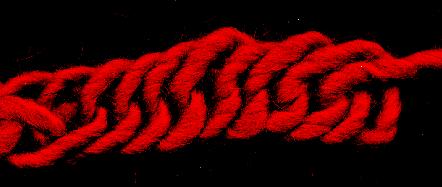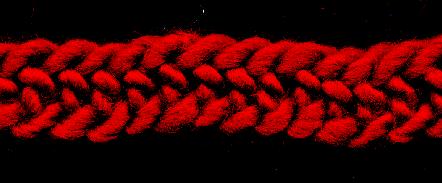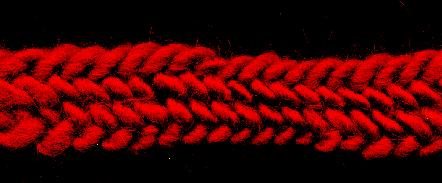

This document contains a list of nålebinding pieces dated to the Viking Age in northern Europe, along with discussions of the stitches utilized. References to competing nomenclatures are included. Objects that pre- and post-date the Viking Age are not included in this work. For this purpose the Viking Age is defined as approximately 800-1066 C.E.
Certain sacrifices in presentation have had to be made, particularly with respect to Nordland's notation system and the Polish letters in the Nahlik citation. The convention I adopted for representing Nordland's notation is discussed below; for the Nahlik citation I simplified certain letters to their closest Roman equivalents, with regret for the necessity.
This document is a work in progress. It is provided as is without any express or implied warranties. While every effort has been taken to ensure the accuracy of the information contained, the author assumes no responsibility for errors or omissions, or for damages resulting from the use of the information contained herein.
Permission is granted to make and distribute verbatim copies of this document for non-commercial private research purposes provided the copyright notice and this permission notice are preserved on all copies.
© 2001 Carolyn Priest-Dorman
The number of verifiable finds of Viking Age nålebinding is, alas, quite small. So, while we know that nålebinding was practiced in the Viking Age, we don't know much about what was actually produced. This work will list as many known pieces in the technique as I can find, with as much supporting evidence as I can find. The order of items will be determined by the complexity of their stitch technique according to Margrethe Hald's system. Cross-references to the nomenclature of Odd Nordlund, Egon Hansen, and Larry Schmitt will be included. An annotated bibliography follows the text.
Each stitch is illustrated twice. The first illustration is the stitch rendered in perle cotton #3, for structural purposes. The second illustration is the stitch rendered in bulky weight wool.
Due to the limitations of HTML in representing superscripts, I have used the following convention in all occurrences of Nordland's notational scheme. The first number is represented normally, e.g., 4. The superscripted number or numbers that follow are represented in square brackets, e.g., [12]. Accordingly, 4[12] refers to Nordland's notation of 4 followed by a superscript 12.
Hald doesn't cite any pieces in the plain "Type II" category, because the only known piece in this technique wasn't discovered until after her system was published. But since this piece is in a four-loop technique, it rightly belongs here. Nordland also doesn't have a reference for this stitch, for the same reason as Hald, but in his system it would be 4[3]. Hansen's notation calls this stitch UU/OOO F2. Larry Schmitt calls it "York stitch." Rows of this stitch, and items made from it, corkscrew markedly in the Z direction.


This stitch was used on at least part of a shoe liner (or possibly a sock) from Period 4B of the Coppergate site, a mid-tenth century Anglo-Scandinavian archaeological site at Jorvík (York) in England. It is worked with fine wool yarn, S-spun and Z-plied, at a gauge of approximately 3.6 rows per centimeter (Walton 1989, 342).
Nordland's notation calls this 4[12]. Hansen's notation calls this stitch UO/UOO F1. Larry Schmitt calls it "Oslo stitch." As Viking nålebinding goes, this is a commonly occurring stitch, with at least three known and geographically disparate examples, all mittens.


The mitten from Lund, which might date to as early as the eleventh century, is in this technique (Nordland, 43).
A fragment from Novgorod is worked in this technique. It is the only known Rus piece from the Viking Age, and it dates to sometime before the middle of the tenth century. It is not certain what type of garment the fragment comes from, but Adam Nahlik suggests that it was either a mitten or a shoe liner (Nahlik, 60-62, 143; Figure 18). It is not clear from the photo whether the yarn is a single or a plied yarn, but the twist apparent on the surface of the yarn is in the Z direction.
A tenth-century mitten from Arnheiðarstaðir, Iceland, is also worked in this technique (Hald, 304; Nordland, 41).
An eleventh century mitten from the lowest levels of the Oslo excavations is also worked in this technique (Nordland, 42f and Figure 23). The photo in Nordland seems to indicate the use of an S-plied yarn.
Nordland's notation calls this 5[22]. In Hansen's notation this stitch would be UOO/UUOO F1 or F2, although Hansen himself once referred to it as OUU/OOUU B2 (Hansen 1991, 145), i.e., worked from the other side. Larry Schmitt calls it "Korgen stitch." This stitch spirals slightly in the S direction.


The major known pieces in this technique are the ones from the rich tenth-century man's grave at Mammen, Bjerringhøj, Denmark. They are openwork panels of mesh framed in silk and brocaded tablet weaving. The mesh is worked in spun-silver thread with small rectangular sections of spun-gold thread (Hansen 1991, 148). Based on evidence from manuscript illuminations, the resultant tapering pieces are now believed to have been decorative terminals to the man's cloak ties and have been reconstructed as such.
A few fragments from either stockings or mittens come from Viking Age women's graves at Kekomäki, Finland. They are worked in this technique using three colors (Hald, 306).
The mitten fragment from Eura Grave 56 (Lehtosalo-Hilander 1982, plate 28) has not been analyzed yet. I can't make out the stitch from the photograph. If someone does figure it out, I'd love to hear about it!
Hald, Margrethe. Ancient Danish Textiles from Bogs and Burials: A Comparative Study of Costume and Iron Age Textiles, translated by Jean Olsen. Publications of the National Museum, Archaeological-Historical Series, Vol. XXI. Copenhagen: National Museum of Denmark, 1980.
A lengthy section, illustrated with a great many photos and schematics, establishes a typology based on the total number of loops intersected in an interlacement. Includes many references to other works on the topic.
Hansen, Egon H. "Nalebinding: definition and description." Textiles in Northern Archaeology: NESAT III Textile Symposium in York 6-9 May 1987, ed. Penelope Walton and John P. Wild, pp. 21-27. London: Archetype Publications, 1990.
Presents a notational system for describing nålebinding stitches that is based on the course the thread takes in traversing each stitch. No historical information included, but lots of technical plates of interlacement variants.
Schmitt, Larry. Lessons in Nålbinding: Lots of Socks. Cottage Grove, Wisconsin: Lawrence W. Schmitt, 2000.
Provides convenient shorthand names for several stitches, although they might not be the first ones that come to the mind of someone specifically interested in Viking Age nålebinding. Also fluent in Hansen's terminology. Good practical information on making usable items, too, including an interpretation of the Jorví shoe liner.
Nordland, Odd. Primitive Scandinavian Textiles in Knotless Netting. Studia Norvegica, no. 10. Oslo: Oslo University Press, 1961.
Presents a notational system that combines the information about number of loops intersected with the specific topological course the thread takes. Based on a broad survey of extant nålebinding pieces in Scandinavian collections, he seeks to identify local traditions for stitch usage across Scandinavia. Also speculates on the relationship between the development of interlacement techniques on textiles and the interlacements of nålebinding.
[Council of Europe "Cultural Routes" Programme.] The World of the Vikings, CD-ROM for Windows. York Archaeological Trust, National Museum of Denmark, Multimedia Management and Past Forward, Ltd., 1994.
An image of the Lund mitten and several of the Mammen nålebinding.
Englund, Sonia Berlin. Brickvaevning sa in i Norden. Kalmar: 1994.
Two close-up photos of the reproduced cloak tags from the Mammen grave, including the nålebinding panels.
Hall, Richard. The Viking Dig: The Excavations at York. London: The Bodley Head, 1984.
A photo of the Jorvík shoe liner.
Hansen, Egon H. "Nalebinding og brikvaevning fra Mammengraven,"Mammen: Grav, kunst og samfund i vikingetid, ed. Mette Iversen, Ulf Näsman, and Jens Vellev, pp. 145-148. Viborg Stiftsmuseums raekke bind 1. Jysk Arkaeologisk Selskabs Skrifter 28. Viborg, 1991.
Danish article with short English summary. Describes the technique of the cloak tags from the Mammen burial. No photos in this essay, but there are several elsewhere in the book.
Lehtosalo-Hilander, Pirkko-Liisa. Ancient Finnish Costumes. Helsinki: The Finnish Archaeological Society, 1984.
Mentions remnants of nålebinding from Viking-era graves such as the mitten from Eura Grave 56.
Lehtosalo-Hilander, Pirkko-Liisa. Luistari I: The Graves. Suomen Muinaismuistoyhdistyksen Aikakauskirja Finska Fornminnesföreningens Tidskrift 82:1. Helsinki, 1982.
A photo of the nålebinding mitten fragment from Eura Grave 56 which dates to the early eleventh century.
Nahlik, Adam. Tkaniny Welniane Importowane i Miejscowe Nowogrodu Wielkiego X-XV Wieku, trans. Jadwiga Packiewizcówna. Wroclaw / Warszawa / Kraków: Zaklad Narodowy Imienia Ossolinskich Wydawnictwo Polskiej Akademii Nauk, 1964.
Textiles from Novgorod, tenth to fifteenth centuries, with emphasis on wool types. One b/w photo of a small section of nålebinding. Mentions ten pieces of nålebinding, of which only one is Viking Age. Summary translation into French at the back.
Walton, Penelope. "Textile Production at Coppergate, York: Anglo-Saxon or Viking?" Textiles in Northern Archaeology: NESAT III Textile Symposium in York 6-9 May 1987, ed. Penelope Walton and John P. Wild, pp. 61-72. London: Archetype Publications, 1990.
Photo, schematic, and brief information about the Coppergate shoe liner.-----. Textiles, Cordage and Raw Fibre from 16-22 Coppergate. The Archaeology of York, Volume 17, Fascicule 5. York: York Archaeological Trust and the Council for British Archaeology, 1989.
An excellent section on the tenth-century nålebinding shoe liner from the Anglo-Scandinavian levels at York, England; includes comparative materials, not all of them Viking Age.
Wild, John Peter. Textiles in Archaeology. Shire Archaeology 56. Aylesbury, UK: Shire Publications Ltd., 1988.
Mention of nålebinding and a photo of the Jorvík shoe liner.
This page was created on 7 January 2001 and last updated on 23 February 2001.
Search this site | Back to Þóra's Textile Resources | Back to Þóra's Viking Resources No soliciting! capriest@cs.vassar.edu